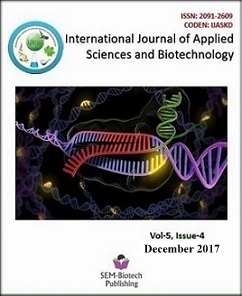Synergistic Effect of Combined Antibiotic and Methanol Extract of Eucalyptus camaldulensis leaf Against Staphylococcus aureus and Pseudomonas aeruginosa
DOI:
https://doi.org/10.3126/ijasbt.v5i4.18620Keywords:
Plant extract, E. camaldulensis, Synergistic effect, Virulence factor, TEM investigation.Abstract
A total of seventy-five medical specimens were collected from different patients admitted to Zagazig university hospital, Egypt. The selected bacterial isolates were distributed as 45 Gram negative bacterial isolates (60%) and 30 Gram positive bacterial isolates (40%). The most effective antibiotic was gentamycin (76%) followed by amikacin and nitrofurantoin. The multi-drug resistant (MDR) bacterial isolates were selected and identified to four groups; Pseudomonas aeruginosa, Klebsiella pneumoniae, Escherichia coli and Staphylococcus aureus. The selected isolates were screened for their capability of biofilm, hemolysins, lecithinase and protease production. S. aureus AM23 and P. aeruginosa AM41 were selected as the highest biofilm and degrading enzymes producers. Furthermore, twenty-four methanolic and aqueous crude extracts derived from different medicinal plants in Egypt were screened for their antibacterial activity against both selected MDR strains. Methanolic extract of Eucalyptus camaldulensis leaf showed the greatest effect on the tested bacteria. Also, there was a synergistic effect of combined E. camaldulensis leaf extract and antibiotics (Gentamycin and Ceftriaxone) against tested organisms. Transmission electron microscopy showed changes in cell shapes, size, contents and cell envelop of antimicrobials treated bacterial cells compared to the control. Our findings proved that the leaf extracts of E. camaldulensis had great potential as antimicrobial agents in the treatment of infectious organisms.
Int. J. Appl. Sci. Biotechnol. Vol 5(4): 486-497




